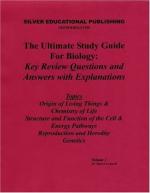|
This section contains 1,174 words (approx. 4 pages at 300 words per page) |

|
Structure of Cells and Heredity
Genetics
The structure of a cell is as follows:
The nucleus is bounded by a double-nuclear membrane with many tiny pores that connect at various places with the endoplasmic reticulum.
The pores allow the transportation of materials into and out of the nucleus within the cytoplasm.
The nucleus contains a dense body, the nucleolus, together with a tangle of fine threads, called chromatids, when the cell is not dividing.
These chromatids become chromosomes, which make their appearance when cell division occurs.
The chromosomes carry hereditary material that determines the organism's characteristics and transmits these characteristics to subsequent generations.
The nucleoplasm is the protoplasm of the nucleus of a cell. It contains one or two small spherical bodies called nucleoli, which produce ribonucleoprotein.
Chromosomes
Chromosomes are found inside the nucleus and are found in pairs; the only exception to this is the gametes where sperm/ova have only...
|
This section contains 1,174 words (approx. 4 pages at 300 words per page) |

|


